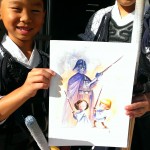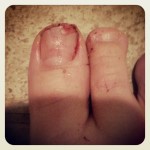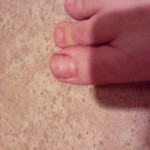Look at those happy faces! I got a commissioned watercolor/ink/pen by Thomas Boatwright. Check him out. His commissions, I think, are very inexpensive and he’ll draw almost whatever you want.
Category Archives: Blog
AUSKF Jrs. 2013
My son’s first match at the nationals.
Broke a nail
Yay!
gave the design to ebogu. the men looks much better :).
http://www.e-bogu.com/Keep-Calm-and-Strike-Men-T-shirt-p/ebo-acc-tshirt-kpclm-all.htm
Neato
I used to visit nursing homes/extended care facility with my church when I was younger. Usually we would share our musical talents, but sharing kendo? Hmmm.. neat idea!
43 secs.
Oh well, better luck next time.
Oldest son’s match
Youngest son’s first tournament match
Taikai
Yesterday was the SCKO Memorial Tournament (17th i believe). Both my sons were participating and did quite well.
I, on the other hand need to focus more and do better.
Next time.
Shodan essay
Describe “ki-ken-tai-ichi”. 気剣体一致, 기검체일치
Ki-ken-tai-ichi literally means “Spirit” – “Sword” – “Body” – “One”. While there is a lot of discussion of ki-ken-tai-ichi on the internet, of the many books I have purchased on kendo, I have seen at most a couple sentences devoted to its meaning.
For the most part, these references define ki-ken-tai-ichi as the unification of spirit-sword-body as one. They all mention that to the beginner this would be interpreted as “when you hit, you move your body and stomp your foot as you yell out the area that you strike- all at the same time”.
While this is a fine definition of a valid point (ippon or yuko-datotsu) in kendo matches, most of the explanations hint (but do not explain in great detail) of something more. And like the Zen masters who give their students paradoxes to meditate upon, our koan as kenshi is “ki-ken-tai-ichi.”
I would submit that ki-ken-tai be considered as a whole rather than its individual units. That is to say that the sword is an extension of the body which is an extension of the spirit. So in reality, they are not separate. If we are concentrating on making separate units become unified (i.e., we are making sure our foot lands at the same time as we use kiai and strike the opponent) rather than seeing the outcome of our spirit attacking we are in essence reinforcing the separate-ness of ki, ken and tai. This is the paradox.
The problem is that as adults, we have programmed ourselves to analyze and break things down into their subunits. So we have to unlearn this.
This learning will be life-long and like anything, it is the process to which we come to a solution which is more important than the solution itself.




